December might conjure images of long, dark nights and bleak weather, but in Spain, the last month of the year offers so much more than that! Not only is this a country where the sun shines all year round, but December is a month bursting with festive energy and unique events that make it a delightful time to visit.
This is a month with a real party feel to it. There are several national holidays, New Year’s Eve, and, of course, Christmas celebrations to enjoy. Towns sparkle with festive lights while cities bustle with vibrant markets of handcrafted gifts, delicious street food and mulled drinks. Christmas is celebrated in style with grand church services, colourful parades and some downright bizarre traditions. And this is a month when you can get your adrenaline-pumping with winter sports, wander the woodlands of Catalonia or take to the waters of the Mediterranean.
Whether you’re sampling local cuisines, witnessing strange yet charming traditions, or enjoying the Mediterranean winter sun, December in Spain promises unforgettable memories!
- ‘Twas the night before Christmas
- Truffle snuffle
- Away in a manger
- Ski season
- Gift shop
- A sailor’s life
- Christmas poo
- Non-festive festivals
- Take the plunge
- Luck, love and fortune
First things first: What’s the weather doing?
As always, the weather in Spain in December is diverse across the different regions. The Canary Islands are, as expected, the warmest place in Spain, with daily temperatures ranging between 16 to 22°C, an average of 10 hours of sunshine per day and only a small chance of rain. The perfect place to enjoy some winter sun.
Along the Mediterranean coast, Barcelona, the Costa Brava and the Balearic Islands enjoy mild temperatures averaging around 10 to 15°C, while further south, places like Valencia and Alicante have slightly warmer averages of 12 to 17°C.
Northern and central Spain have cooler temperatures, between 5 to 10°C, and they see more rainfall than other areas, with around 10 wet days across the month. Madrid is also cool in December but has a very low chance of rain. The capital is known for its crisp winter days with clear blue skies. There is also a possibility of frost at night in these regions.
Temperatures drop below freezing in mountainous regions such as the Pyrenees, Cantabrian Mountains, and the Sierra Nevada. In a good year, snow starts to dust the peaks in November and falls throughout December, creating beautiful landscapes and prime conditions for winter sports.
Now that you know what weather to pack for, let’s start filling up that itinerary! Here are our top ten things to see and do in Spain in December:
‘Twas the night before Christmas
If you want to celebrate Christmas the Spanish way, then you should know it is Christmas Eve, known as Nochebuena, not Christmas Day, which is the star of the festive period. It’s a busy day of feasting with friends and family, attending midnight mass and parading home through the dark streets.
The main Christmas meal is enjoyed on the 24th. The traditional dishes vary throughout Spain, but it’s common to enjoy a charcuterie board of Iberian ham, chorizo and local cheeses followed by fresh seafood or Galets, a flavoursome broth filled with stuffed pasta shells. Some families might enjoy roast turkey (sometimes stuffed with local truffles), while others enjoy a suckling pig or roast lamb. But whatever is for the main course, there are always plenty of sweet treats for afterwards. Expect to see marzipan sweets, polvorones – crumbly butter biscuits dusted with sugar, and Turrón – nougat filled with nuts, candied fruit or coconut.
After the meal, it’s customary to attend midnight mass. La Misa Del Gallo, or the Mass of the Rooster, so named for the rooster that supposedly crowed the night Jesus was born. Anyone is welcome to attend, so it’s a perfect opportunity to visit one of the country’s majestic cathedrals or churches and experience one of their most impressive services of the year.
If you’re holidaying in Mallorca, you’re in for an additional treat and can experience The Song of the Sibyl. This dramatic performance has been taking place since mediaeval times and consists of a traditional chant set to a Gregorian melody. The haunting song, often delivered acapella by a young boy or girl, is so evocative that it has been declared an Intangible Cultural Heritage by UNESCO. It’s a memorable experience and a must-see for cultural enthusiasts.
Fancy checking out this unique Christmas tradition? Book accommodation in Mallorca and head to the Palma Cathedral to catch the island’s largest performance.
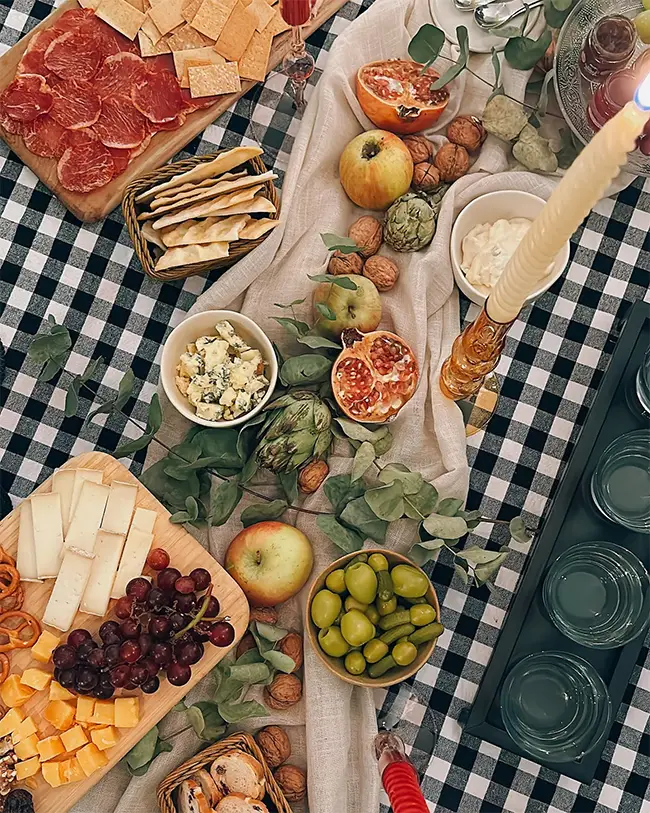
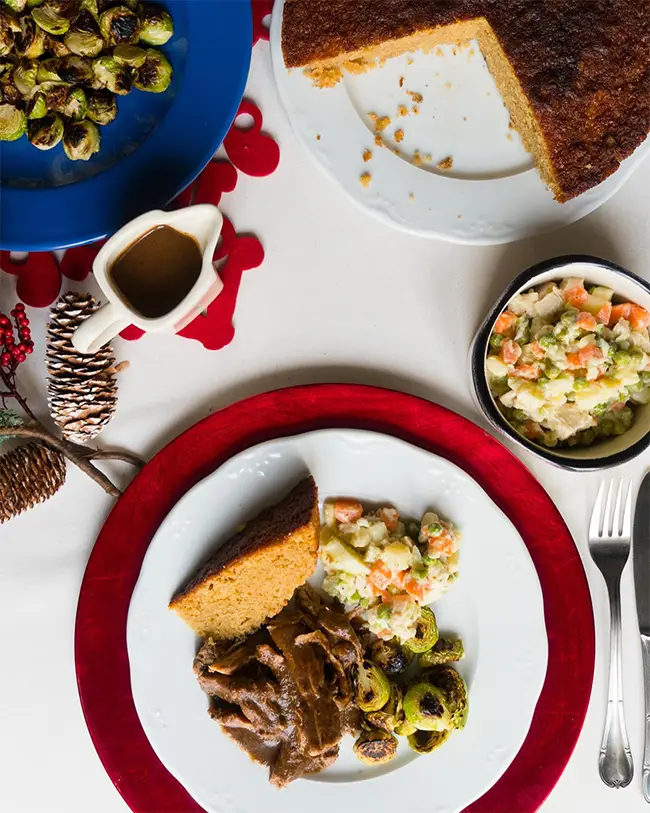
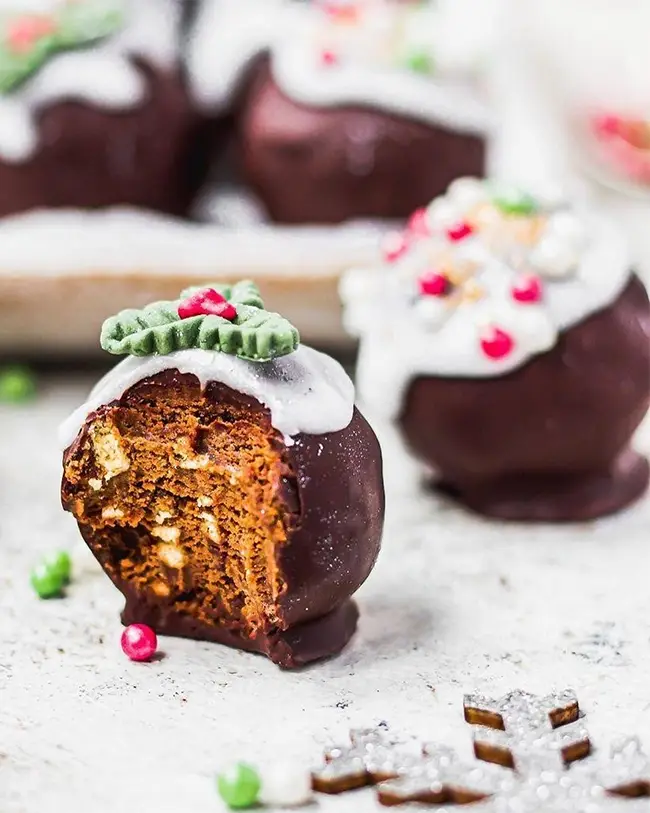
Truffle snuffle
In November, we talked about the much-loved Catalonian tradition of mushroom foraging. This is still very much underway in December, with the added bonus that you can now also forage for another delicacy – truffles!
Spain is the world’s largest producer of Black Truffles or Winter Truffles. These are one of the most delicious truffle varieties and can sell for upwards of €1,000 per kg. They grow best from mid-November to mid-March when the damp soil reaches the perfect growing conditions, and one of the best places to find them is in the Girona forests, Catalonia.
However, the chances of you heading out into the woods and locating them yourself are almost nonexistent. That’s why you need the help of a knowledgeable local guide and, more importantly, a truffle-hunting dog! These highly trained canines can pick up the potent scent of truffles from over 100 metres away.
Join an organised truffle hunting tour in Catalonia, and you’ll be taken to the best truffle-growing regions, where you’ll follow the twitching noses of expert hounds as they snuffle out the truffles! Once they’ve located the right spot, it’ll be your job to dig carefully into the ground in search of the tasty nugget.Once you’ve collected enough truffles – and mushrooms, too – you’ll head back to base camp to enjoy a meal made with the delicious earthy flavours of your locally foraged bounty.
Fancy digging for nuggets of black gold in the woods of Catalonia? Find accommodation near Girona that is as close to the truffle grounds as possible. Or stay in Barcelona and hop on a truffle hunting day trip.

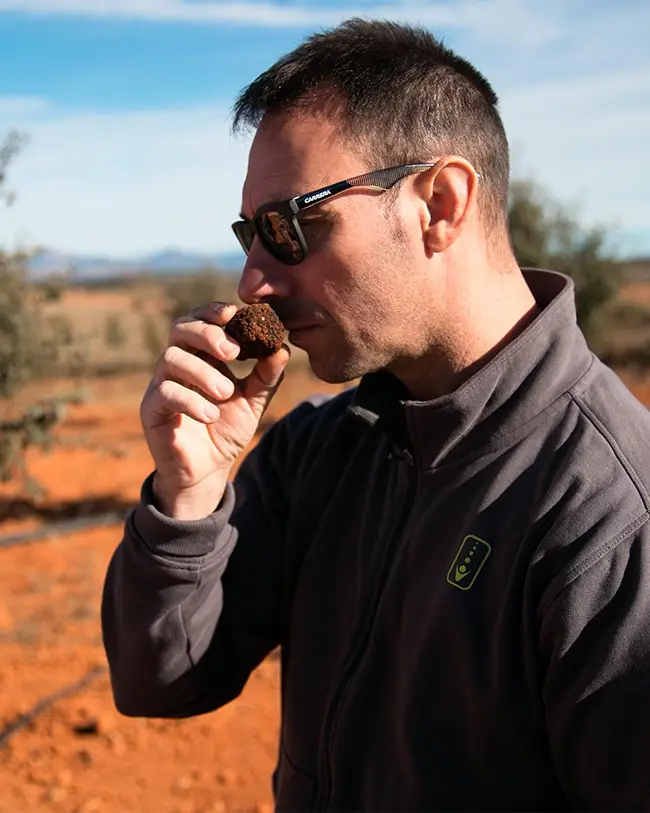
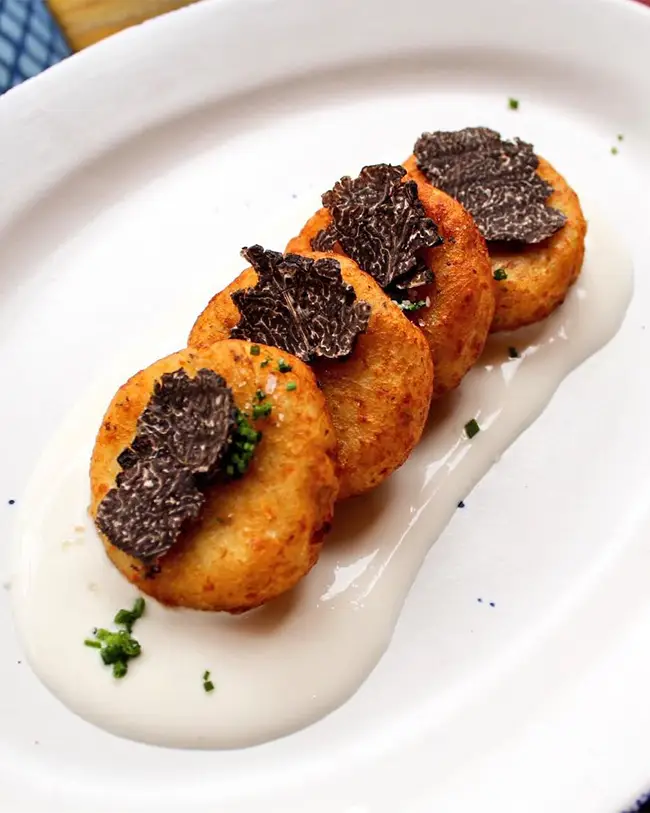
Away in a manger
One much-loved Christmas tradition in Spain is the Belenes, or nativity scenes, which add a fantastic visual element to cities, towns, and villages in the month leading up to Christmas.
Now, most of us are used to seeing the little stable scene of a few people gathered around a crib with sheep and donkeys looking on, but in Spain, these scenes are far more involved than that. The word Belene is derived from the word Bethlehem, and the scenes can depict not just that all-important stable but also the entire surrounding village and neighbouring ones, sometimes including hundreds of figures of people and animals.
You’ll see Belenes everywhere: in peoples’ windows, on shop floors, in the corners of restaurants, and, of course, taking over town squares. They can be any size, from a shoebox miniature to a life-size scene, from the very traditional to the quirky or avant-garde. Often, businesses compete to have the most elaborate, beautiful or unusual scene and viewing them all to choose your favourite is a lovely way to explore a town at Christmas.
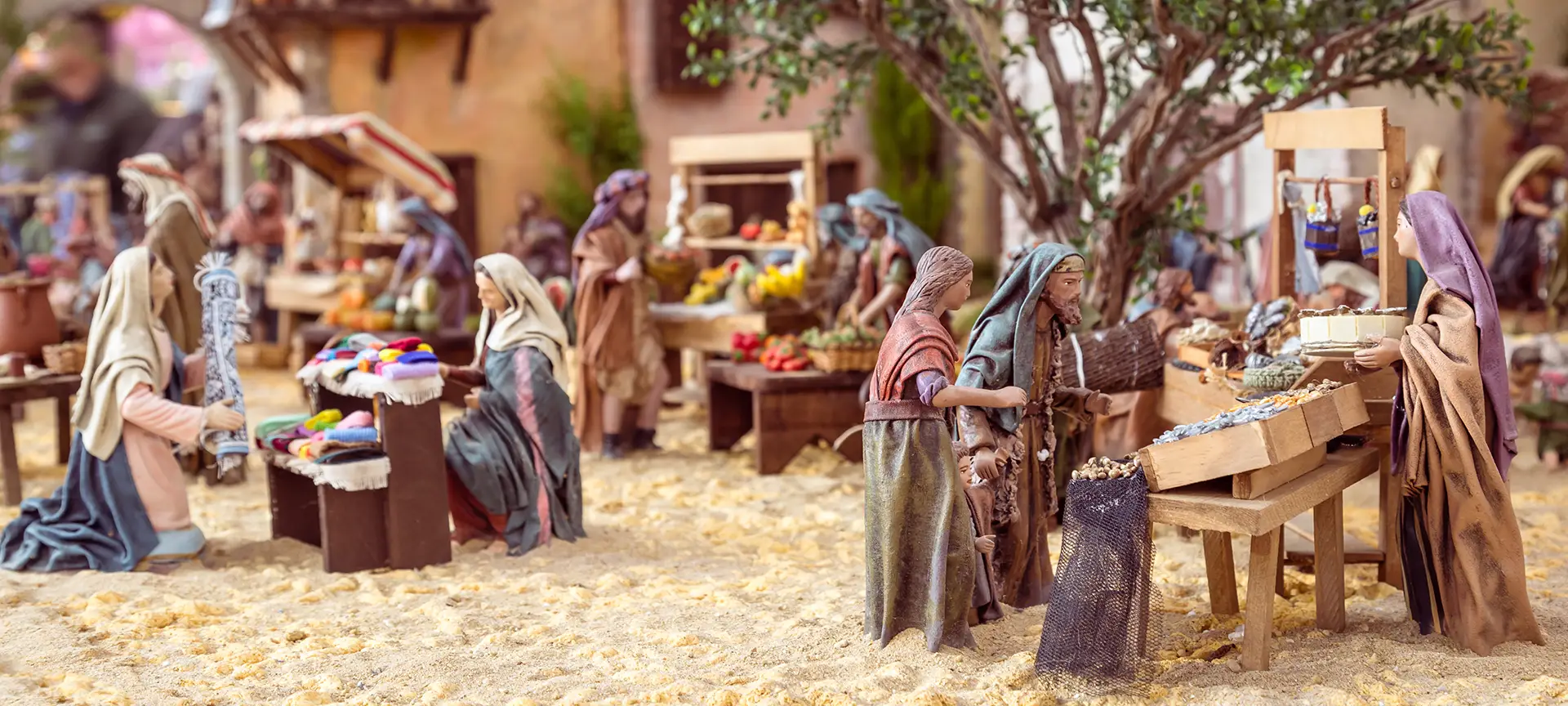
Arcos de la Frontera in Andalusia has a vast Belen Viviente, or Living Nativity, populated with real people and animals, which attracts thousands of people to see it yearly. Alternatively, Rute in Cordoba is home to the world’s largest chocolate nativity. A delicious scene that takes more than 1,600 kilograms of chocolate to make!
And in Catalonia, see if you can spot the unusual figure hiding amongst the nativities. It is traditional to include the figure of El Caganer, which means ‘the pooper’. And yes, it is as it sounds. Somewhere in the scene, you’ll spot a figurine squatting with its trousers around its ankles, bum out, taking a poo. The exact reason for this inclusion is debatable. Some say he represents fertilising the earth and he brings good luck for the coming year – but it’s possible Catalonians just have a funny sense of humour. The strangest part is that this is not the only poo-related Spanish Christmas tradition (more on that later).
El Caganer is usually depicted as a man in traditional peasant clothes, but sometimes he is made to look like a celebrity, politician, cartoon character or local figure. Choose your own pooping figurine from the many available at the Christmas markets and take El Caganer home and add to your nativity scene!
Want to wander the festive streets of Spain viewing the nativity scenes and choosing your favourite? Check out rooms in Spain now to make sure you get your perfect Christmas accommodation.
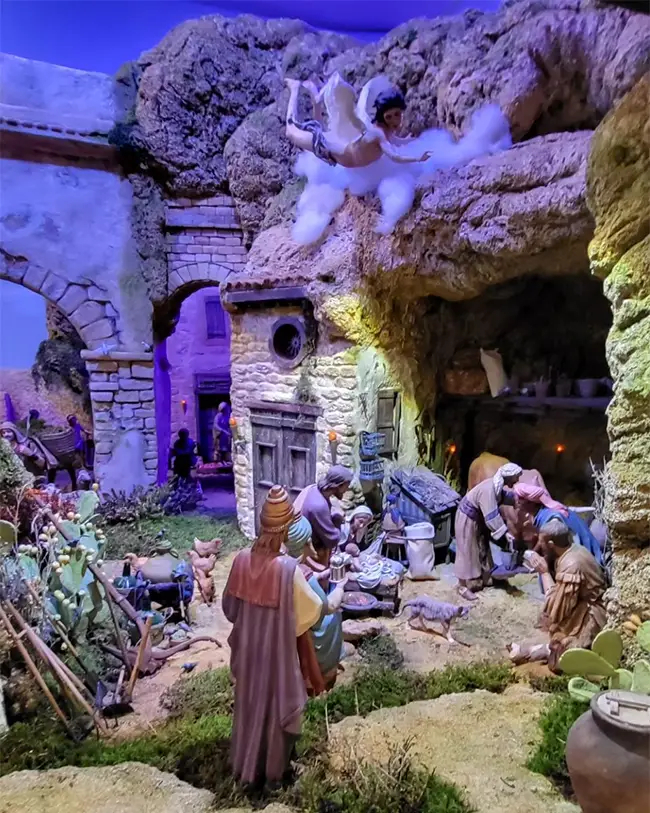
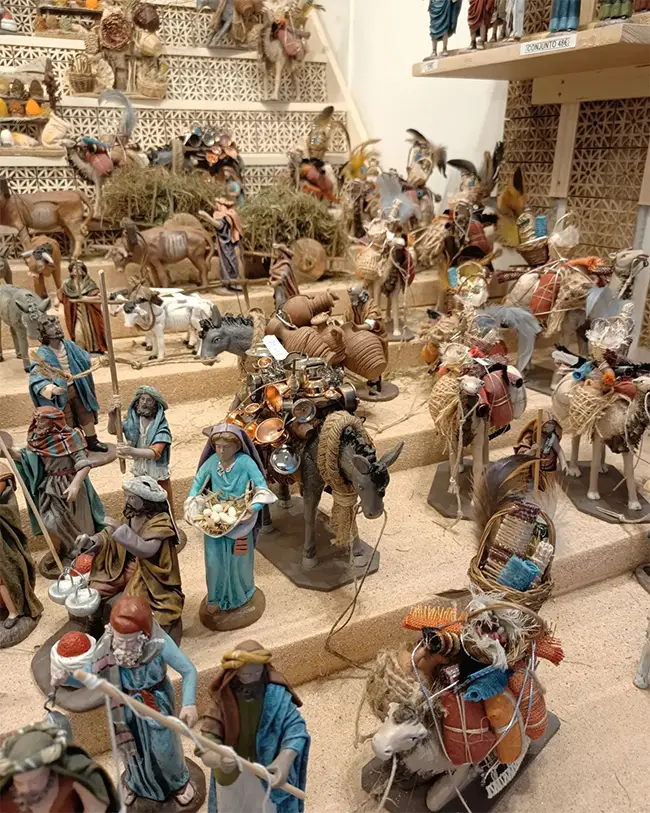

Ski season
Spain might not be the first place that comes to mind when you think of skiing in Europe, but perhaps it should be. It’s home to many excellent ski resorts, with terrain for all abilities, modern facilities, awesome complementary activities and, of course, fantastic apres-ski. And the fact that it’s a lesser-known country for skiing comes with its perks – namely lower prices and fewer crowds than the more famous resorts of France and Switzerland.
While most of the country’s ski resorts are located in the north of the country, one of the most famous, Sierra Nevada, is all the way in the south. It’s the most southern resort in Europe and also one of the most beautiful, with spectacular scenery and stunning views from its towering mountain peaks. There are over 100 kilometres of slopes with trails for all capabilities and all the amenities you could wish for, and it’s just 1½ hours from Granada Airport.
More traditionally located is Baqueira-Beret in the Catalan Pyrenees; this is one of the largest ski resorts in the country and arguably the best. It’s a favourite with the Spanish royal family and the wealthy elites of Barcelona and Madrid, but it still costs less than skiing elsewhere in Europe. It’s known for having modern lifts and snowmaking equipment, around 160 kilometres of perfectly maintained runs, and even heli-skiing options.
If you fancy something on a smaller scale, check out Astún and Candanchú. Located in the Aragonese Pyrenees near the French border, they are ideal for families with relaxed vibes, great snow conditions, and affordable prices. A joint ski pass can be purchased for both areas.
With over 30 ski resorts to choose from, you’ll be spoilt for choice when it comes to skiing and snowboarding in Spain, and you can definitely find a resort that suits you.
Fancy getting on those slopes? Check out accommodation in or near your favourite resort today, then dig out those thermals!

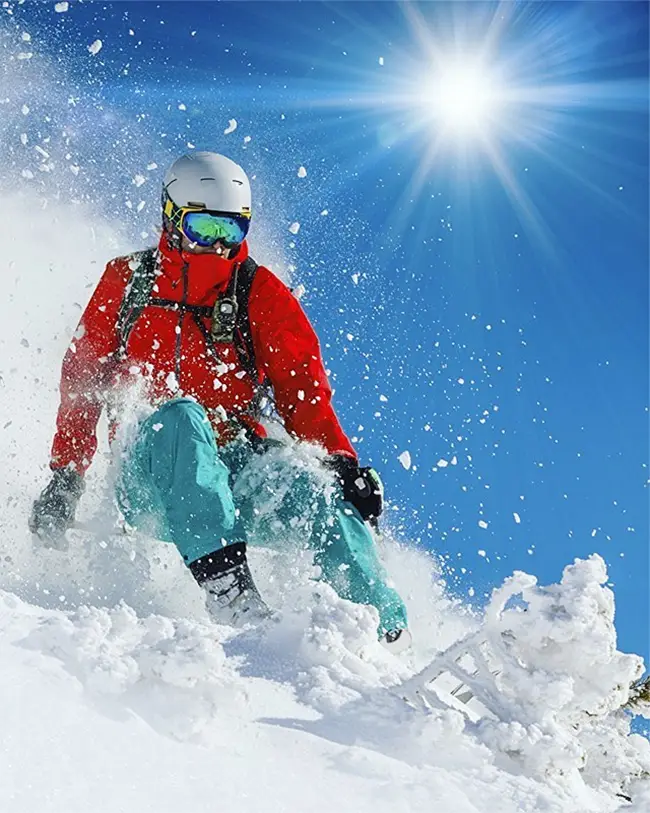
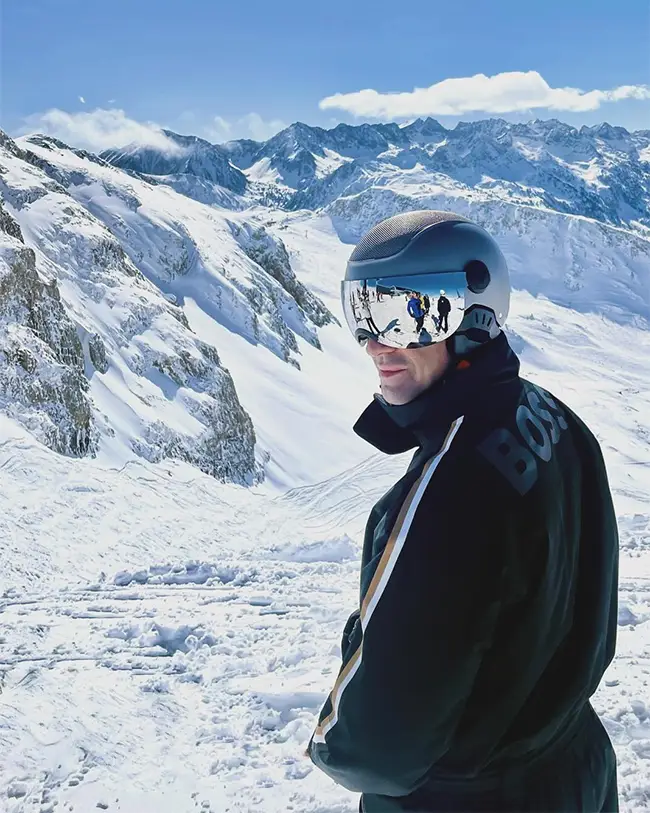
Gift shop
One of our favourite things to do in Spain in December is to wander the Christmas markets, shopping for handcrafted gifts, unique souvenirs, and traditional decorations amidst the smell of roasting chestnuts, frying churros and mulled wine. It’s a truly magical atmosphere and a great way to get into the festive spirit.
In November, we listed the early birds that got a jump start on the season, but in December, plenty more markets open their doors:
- Barcelona’s oldest and most famous Christmas market is Fira de Santa Llúcia. The Fira de Nadal a la Sagrada Família is slightly smaller but offers you the chance to shop in the gardens of the iconic basilica. Port Vell Fair is a vast modern wonderland at the end of the city’s most famous street, Las Ramblas. This one offers the chance to shop, explore nativity scenes, ride a Ferris wheel and admire one of the city’s biggest Christmas trees.
- The markets in Seville are known for their enchanting ambience and their handmade items that showcase Andalucían crafts. The Feria del Belén market sells figurines and backdrops for you to build and populate your nativity scene, while the Mercado de Navidad on The Plaza de la Magdalena is a traditional Christmas market complete with matching wooden huts in the heart of the old town.
- In Madrid, the city’s biggest (and busiest) Christmas Market occurs in the Plaza Mayor and attracts huge crowds yearly. It’s very busy, but the atmosphere practically crackles with Christmas cheer. An alternative is Mercado de Artesanía in the Plaza de España, dedicated to artisanal crafts and handmade gifts. Or La Navideña Feria Internacional de las Culturas, which celebrates Christmas across the world and is a fantastic place to learn about other cultures’ festive traditions and pick up some unique gift ideas.
- And, if you want to max out on Christmas spirit, visit the province of Pontevedra in Galicia, the self-titled Christmas Capital of Spain. The city of Vigo started it all by putting on incredible, expansive Christmas light displays that got better and better each year. Not to be outdone, the neighbouring towns and cities got involved. Now, the whole province is a festive hub featuring not just Christmas markets but winter wonderlands, illuminated Christmas trees, incredible light shows, Nativity scenes, ice rinks, and fairground rides.
Fancy doing some Christmas shopping on your holiday in Spain? Look for accommodation near your market of choice, then start making your gift list!

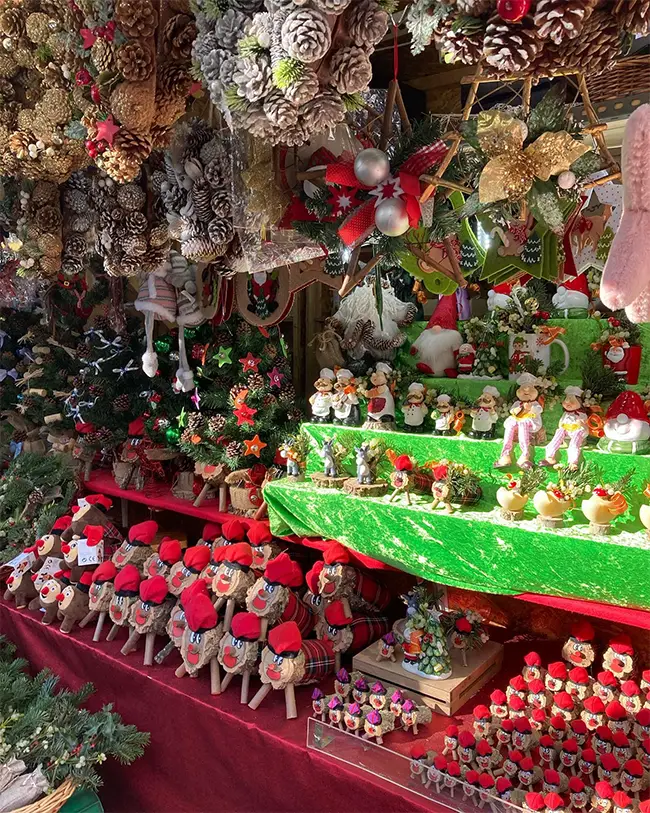
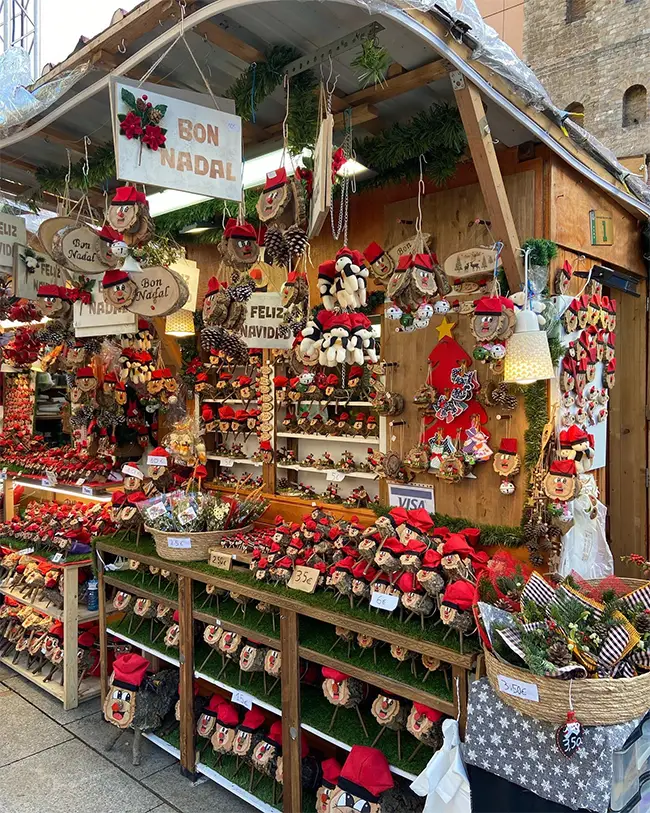
A sailor’s life
You might not want to take to the sea during the coldest month of the year but watching others do so is always enjoyable. December is the month for sailors and sailing enthusiasts to visit Spain as several important regattas and races take place.
- Head to Grand Canaria in the first week of December for the Canary Islands Olympic Sailing Week. This is a significant event on the calendar of European Sailors and part of the Spanish Olympic schedule.
- Visit Palma, Mallorca, for the oldest competitive sport in the Balearics, the Trofeo Ciutat de Palma, which has been held since the 1950s. Watch as over 600 sailors from all over the world compete for this hotly contested trophy.
- Go to the Costa Brava for the annual Christmas Race Regatta in the waters of Palamos. This traditional regatta takes place between the 18th and 22nd of December and is considered the kick-off to the winter sailing season. It’s a training event for Olympic hopefuls and is a fantastic spectacle to enjoy alongside some winter sun.
Fancy watching the sailors in action? Book accommodation in Grand Canaria, Palma or Palamos now to get the best view of the action.


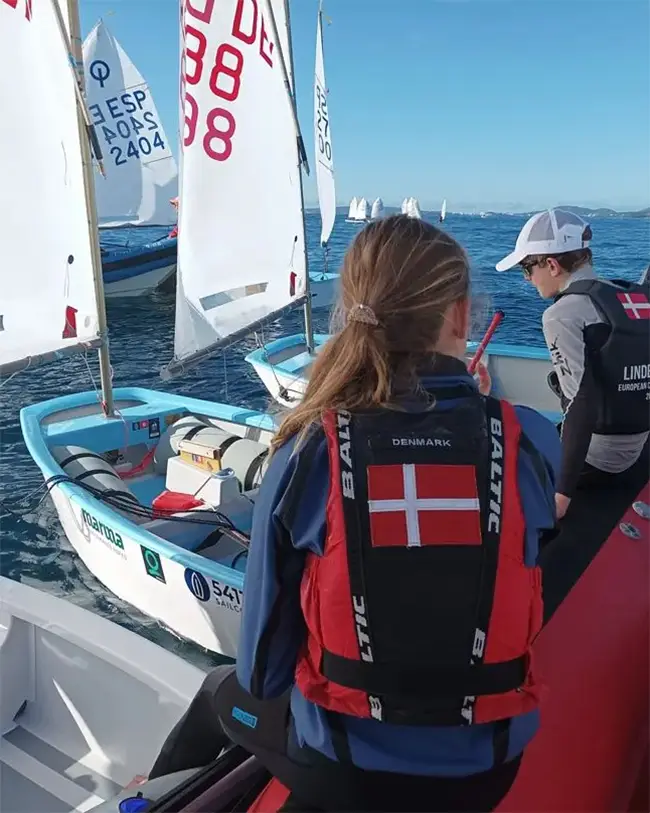
Christmas poo
Want to engage in a truly bizarre Spanish Christmas tradition? Well, grab a log, hit it with a stick and demand that it poo out some presents for you! Nope, we’ve not lost our minds; that’s a real Christmas tradition in Spain, specifically the Catalan region.
Santa Claus is not a big part of Christmas in Spain, but there is another character that brings presents: Tio de Nadal, the Christmas Log, more commonly known as Caga Tio, the Poo Log.
Caga Tio is a hollow log with a smiley face, little stick legs, and the traditional red hat of Catalonia. At the start of the festive season, he is brought into the house and covered with a blanket to keep him warm. Children feed the log scraps of food and drink, then, on Christmas Day, they sing the traditional Caga Tio song and hit the log with sticks until he ‘poops out’ nuts and sweets and small presents under the blanket.
Pick up an authentic Tio de Nadal at a Christmas market to include him in your holiday activities. The only problem is that the kids will enjoy it so much that you’ll have to take him home and include him in the annual festivities!
Want to spend Christmas in a land where people understand the importance of toilet humour? We don’t blame you. Book your dream accommodation in Catalonia early to avoid missing out.
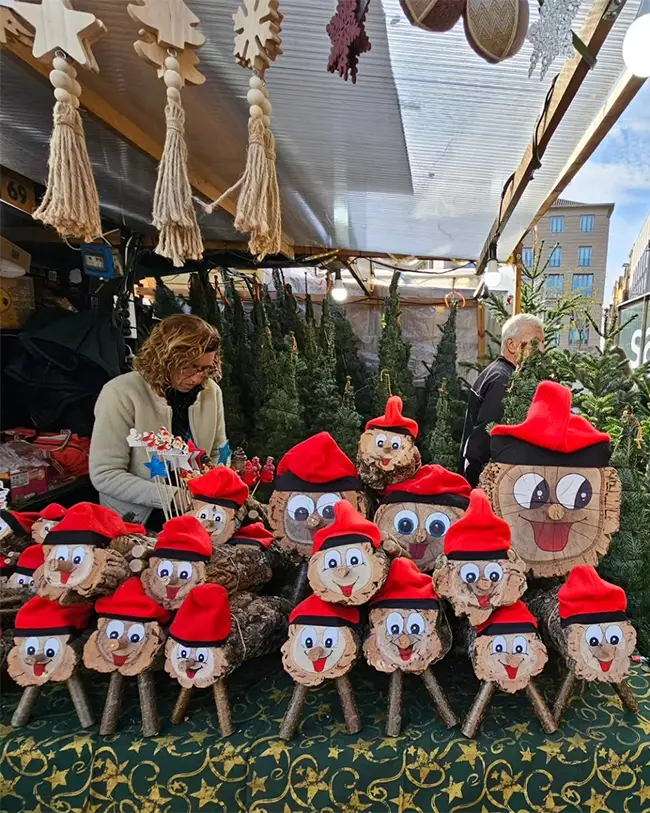
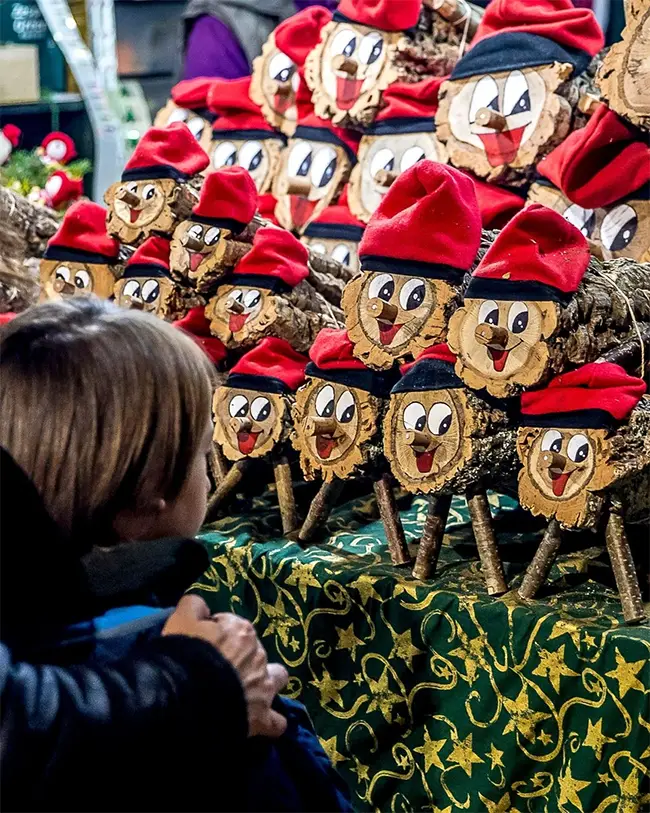
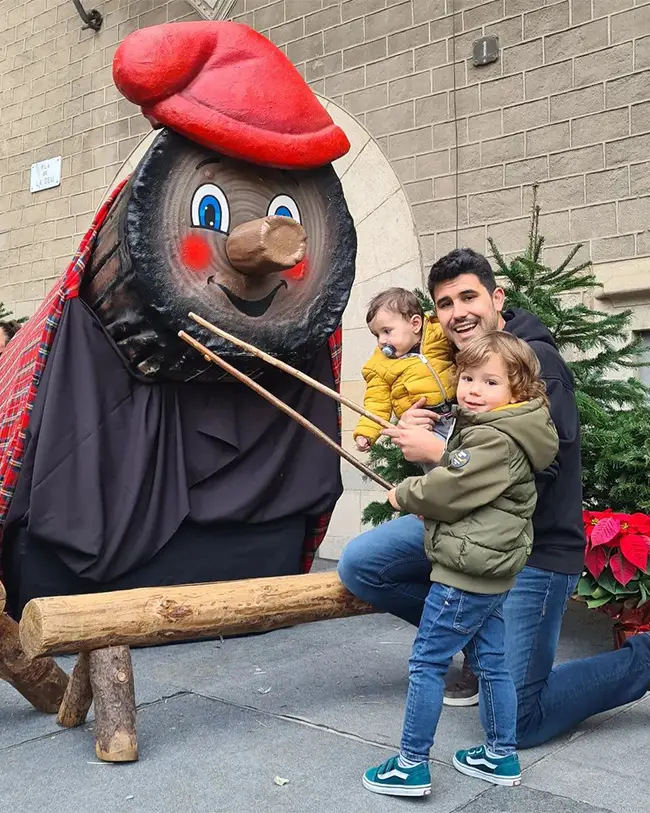
Non-festive festivals
Of course, Christmas is not the only event that happens in December. Here are some non-Christmas-related festivals and dates to put in your calendar:
- Día de los Santos Inocentes: December 28th is the day of the Holy Innocents, the Spanish version of April Fools. This is a day of mischief and mayhem when people play practical jokes and pranks on one another.
- Carnavalcázar is unique in Spain as it is the only Carnival celebration held in December. Alcázar de San Juan comes alive with colourful parades, cultural performances, street parties, elaborate costumes and puppetry. The folk traditions of the carnival mingle surreal with the town’s Christmas ones, making it a fascinating place to spend the holiday.
- Purple Weekend is a celebration of mod culture in Leon, Galicia. For three days at the start of December, the city celebrates the music, costumes, fashion, and art of the 60s with a full performance and exhibition calendar.
- The Feast of the Immaculate Conception, December 8th, is a national holiday in Spain held to honour the Virgin Mary’s conception. It’s marked by religious ceremonies in cathedrals and churches across the country, as well as parades, traditional music and dancing. For many, it marks the start of the festive season and is celebrated with a vibrant enthusiasm.
- Fiestas de la Virgen del Castillo: Every town and village in Spain celebrates its saint’s day differently. From December 5th to 8th, Yecla in Murcia does so with noisy and colourful parades accompanied by gunpowder explosions and delicious gastronomy. This event has been named an event of national tourist interest and is well worth a visit.
- Vic’s Medieval Market: At the start of December, this historic Catalonian town celebrates its heritage with a massive mediaeval market. Wander the meticulously constructed marketplace, shop at artisanal stalls, sample endless local delicacies, watch re-enactments and performances, try your hand at ancient weaponry and games and marvel at the people who go all out in costume and character for the event.
If you want to attend any (or all) of these festivals in December, book your accommodation in Spain early to avoid disappointment.

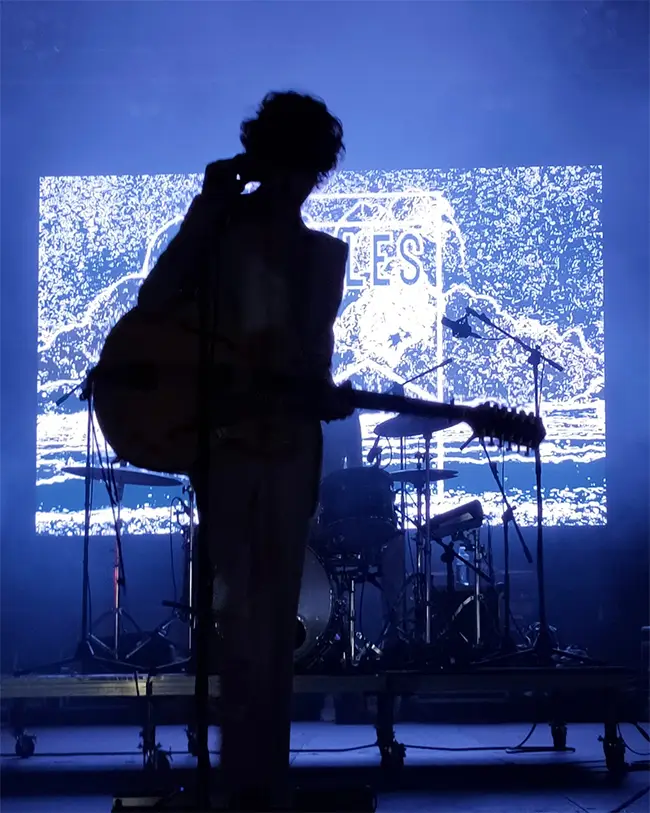
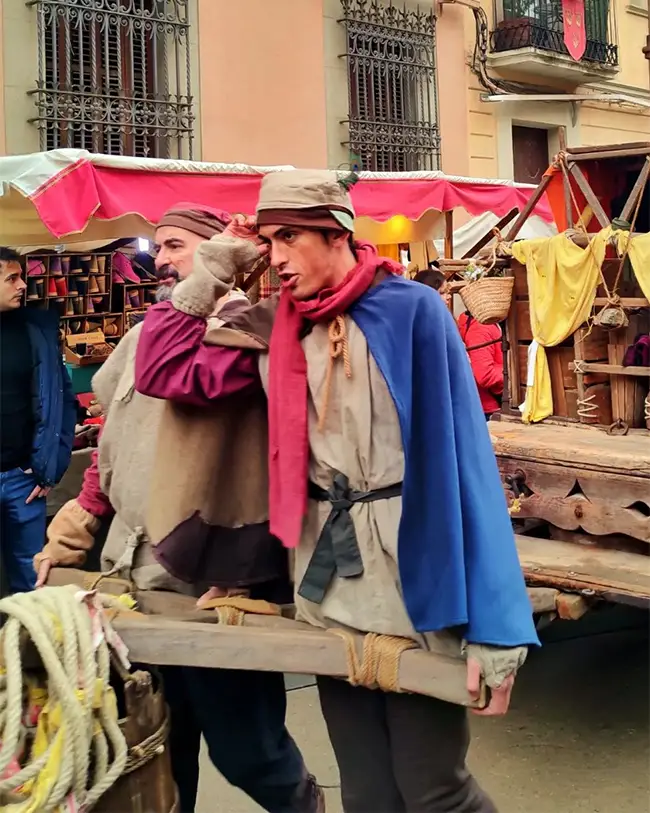
Take the plunge
If you’re in Barcelona for the festival period and want to make the day as memorable as possible, why not plunge into the sea on Christmas morning? Santa hat optional.
If you decide to go for it, you won’t be alone; the Christmas Day harbour swim is a proud tradition in Barcelona that has been going on for over 100 years. It takes place at noon on Christmas day at Portal de la Pau at the end of La Rambla and comprises a 200 metre race across the harbour.
Every year, around 400 brave souls take the plunge into water that drops to around 13°C in December. Participants tend to fit two groups: the speedo-clad racers who take the race seriously and the Santa suit-wearing folk who are just there for a good time.
Hundreds more people gather along the harbour walls and bridges to witness the spectacle, and it’s a festive and fun way to spend Christmas Day, whether you take part in the race or not.
Want to witness shivering Santas diving into winter waters? Look for your ideal accommodation in Barcelona now, then decide whether to join in!
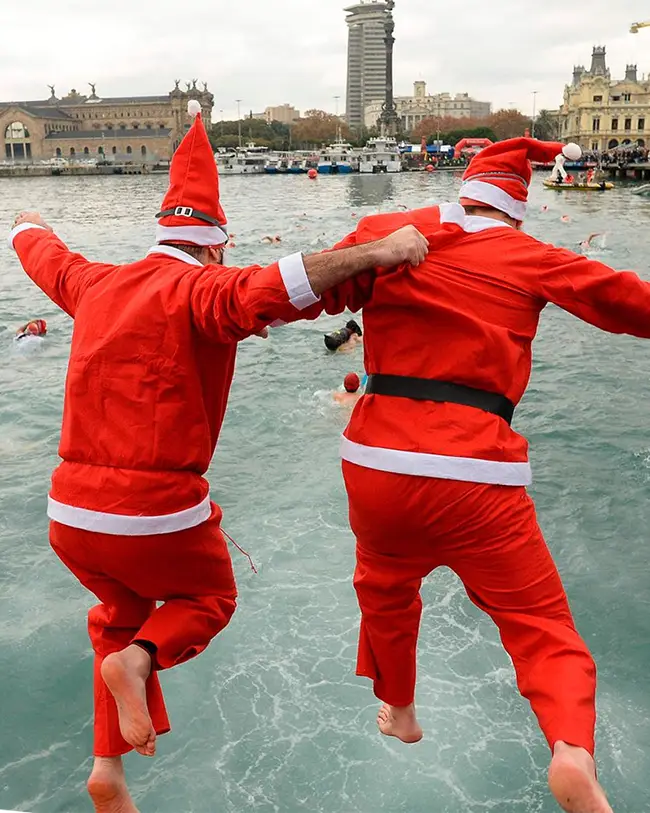
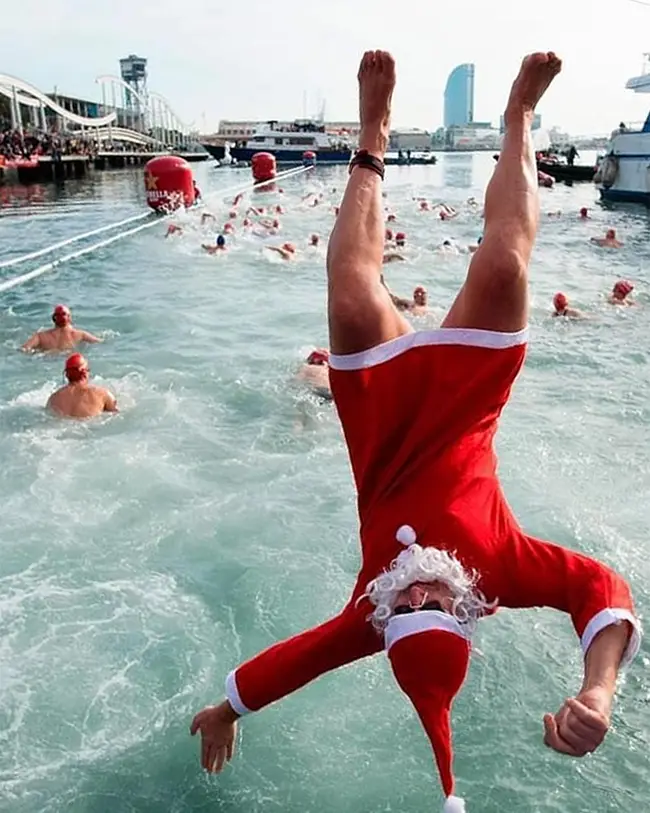
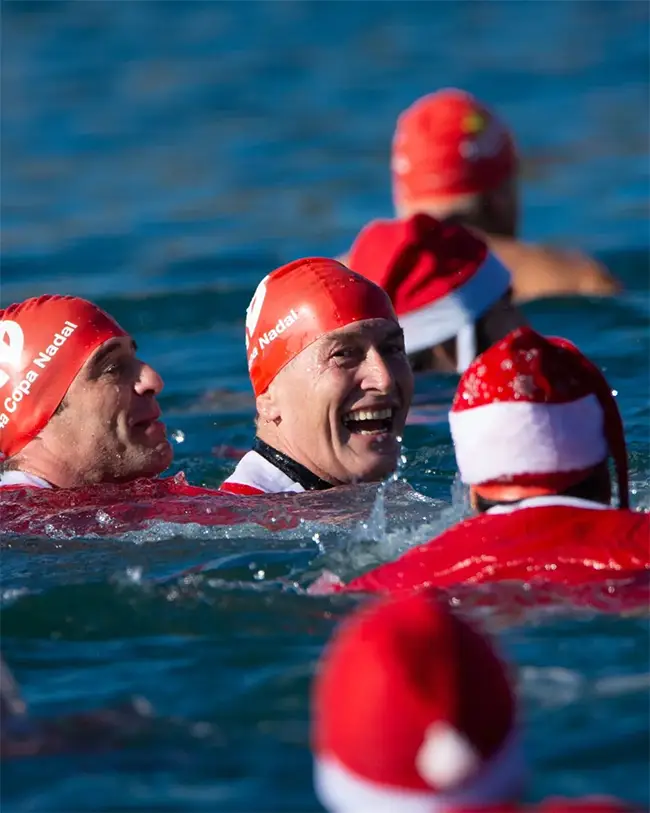
Luck, love and fortune
And, of course, the very last event on the December calendar is New Year’s Eve or Nochevieja. Now we know that the Spanish know how to throw a party, so you can bet that New Year’s celebrations in this country will be unforgettable.
You can, of course, hit up any of the country’s abundant bars and clubs to dance the year away. But if you want to party like the locals do, you need to head to an alfresco fiesta featuring live festive music, food and drink stalls, and fireworks.
One of the best such parties can be found in Madrid’s Puerta del Sol. It’s known for its electric atmosphere and all-night revelry. But if you can’t make it to the capital, don’t worry. Nochevieja parties will be held in the main square of almost every Spanish town and city.
And to make it extra memorable, do as the locals do and include these Spanish traditions as you celebrate the changing of the year:
- Luck. One of the most common New Year’s traditions is to eat grapes at midnight. You must eat one grape after each chime of the clock – this will bring you good luck for each month of the new year!
- Fortune. It’s customary to toast the new year with bubbly, specifically, a glass of Spanish Cava. Drop something gold into the glass, such as a coin or a wedding ring, before drinking; this will bring good fortune to the new year.
- Love. If you’re looking for romance, make sure to wear red underwear under your New Year’s Eve outfit! This is said to attract love for the new year.
Do these three things, and you can be sure your next year will be fantastic! And if it isn’t, well, you’ll at least have the memory of a great party to cheer you up!
What to see in the new year in style? Book accommodation in Madrid as early as possible to ensure you get your perfect accommodation before things get booked up.
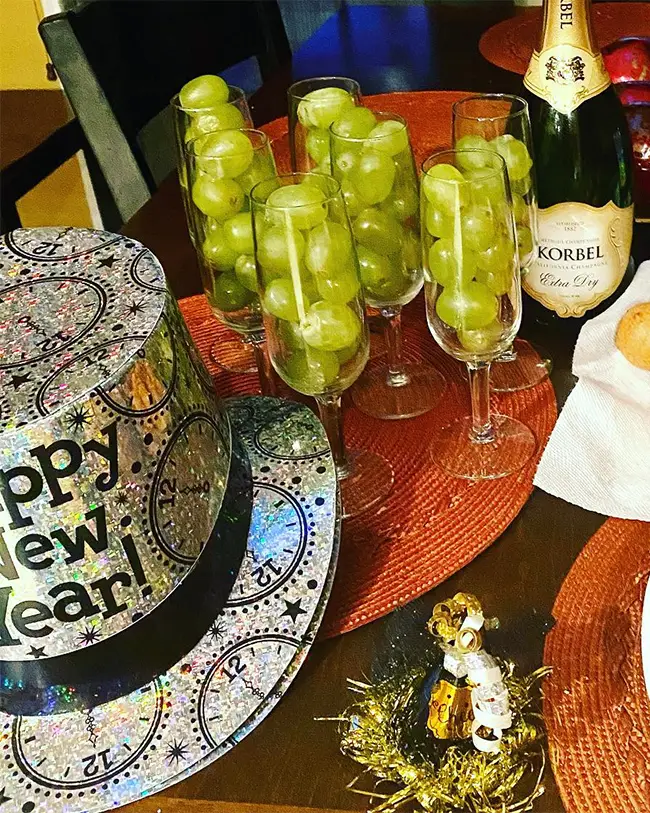
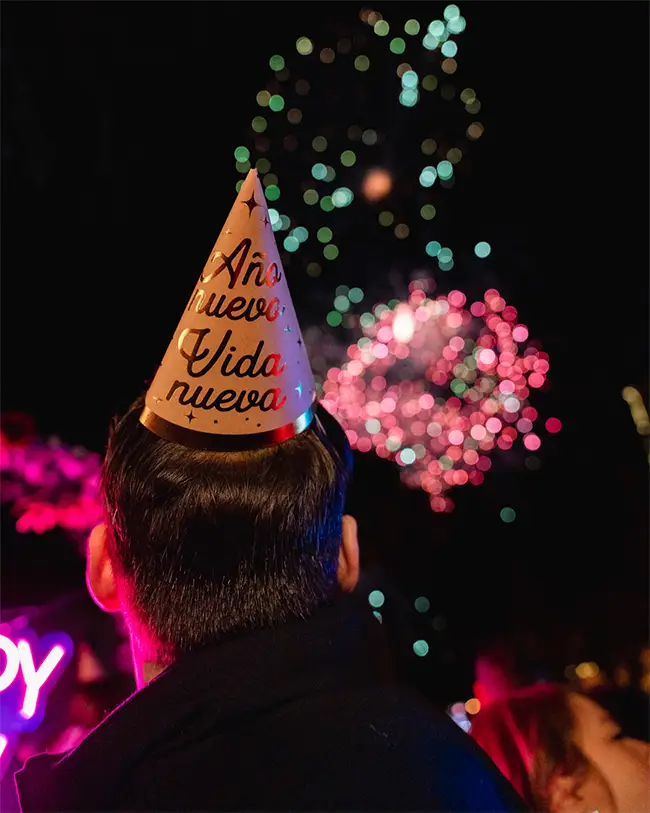
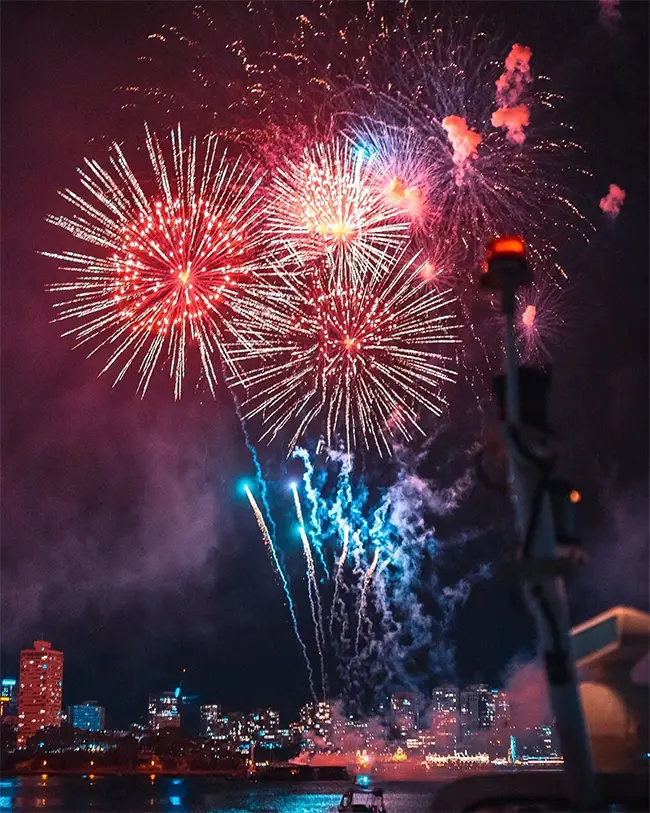
Top tips for travelling in Spain in December
We know planning a holiday can be stressful, so here are some top tips to help your trip to Spain in December go smoothly.
- The weather in December can be changeable; pack warm sweaters and jackets to put on in the evening and layers that you can carry with you on a day out should you need them. Depending on where you’re visiting, it’s worth packing a raincoat and / or umbrella, too.
- The school holidays, coupled with Christmas, make for a mini-peak season in Spain. Expect prices and crowds to rise in December and then rise again over the two weeks of Christmas. Book accommodation, flights and activities as far ahead as possible to get the best price and avoid disappointment.
- December can be a little chaotic in terms of business opening hours. The 6th, 8th and 25th are all national holidays, plus things tend to run differently over the Christmas and New Year weeks. So, it’s a good idea to double-check the opening hours of businesses and activities to be sure everything is running when you need it.
- Similarly, Christmas Eve is generally spent eating with family, so some restaurants will close because of this. If you’re planning on a Christmas Eve dinner out, double-check that your restaurant of choice is open.
So what do you think of our top 10 things to do in Spain in December?
Do you fancy spending a winter holiday in Spain? Can you see yourself shopping at festive markets, wandering the woods in search of truffles, speeding down ski slopes and joining in with the Catalonian obsession with Christmas poo?
If so, search for your dream accommodation now and start planning your perfect December holiday in Spain.
What about next month? Here’s our guide to the top 10 things to do in Spain in January.
I am a huge fan of Spain and knew I would be before I’d ever set foot there. Any country where meals last for hours and afternoon naps are part of the culture is always going to be right up my street! And it did not disappoint. From beach holidays in the Canaries to working in the Balearics to road-tripping through the mainland and city breaks in the country’s urban hubs, I have returned again and again to Spain and will continue to do so for years to come.
